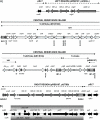Characterization of pUO-StVR2, a virulence-resistance plasmid evolved from the pSLT virulence plasmid of Salmonella enterica serovar Typhimurium
- PMID: 18852276
- PMCID: PMC2592850
- DOI: 10.1128/AAC.00563-08
Characterization of pUO-StVR2, a virulence-resistance plasmid evolved from the pSLT virulence plasmid of Salmonella enterica serovar Typhimurium
Abstract
pUO-StVR2 is a virulence-resistance plasmid which originated from pSLT of Salmonella enterica serovar Typhimurium through acquisition of a complex resistance island, flanked by regions that provide a toxin-antitoxin system and an iron uptake system. The presence of resistance and virulence determinants on the same plasmid allows coselection of both properties, potentially increasing health risks.
Figures


Similar articles
-
Efficient mobilization of a resistance derivative of pSLT, the virulence plasmid specific of Salmonella enterica serovar Typhimurium, by an IncI1 plasmid.Plasmid. 2013 Jul;70(1):104-9. doi: 10.1016/j.plasmid.2013.03.002. Epub 2013 Mar 27. Plasmid. 2013. PMID: 23541844
-
Transposition and homologous recombination drive evolution of pUO-StVR2, a multidrug resistance derivative of pSLT, the virulence plasmid specific of Salmonella enterica serovar Typhimurium.Infect Genet Evol. 2015 Jan;29:99-102. doi: 10.1016/j.meegid.2014.11.010. Epub 2014 Nov 18. Infect Genet Evol. 2015. PMID: 25461846
-
Salmonella enterica serovar Typhimurium virulence-resistance plasmids derived from the pSLT carrying nonconventional class 1 integrons with dfrA12 gene in their variable region and sul3 in the 3' conserved segment.Microb Drug Resist. 2013 Dec;19(6):437-45. doi: 10.1089/mdr.2012.0226. Epub 2013 Jun 29. Microb Drug Resist. 2013. PMID: 23808958
-
Evolution of the virulence plasmids of non-typhoid Salmonella and its association with antimicrobial resistance.Microbes Infect. 2006 Jun;8(7):1931-6. doi: 10.1016/j.micinf.2005.12.026. Epub 2006 Mar 27. Microbes Infect. 2006. PMID: 16713725 Review.
-
Molecular characterization, spread and evolution of multidrug resistance in Salmonella enterica typhimurium DT104.Vet Res. 2001 May-Aug;32(3-4):301-10. doi: 10.1051/vetres:2001126. Vet Res. 2001. PMID: 11432421 Review.
Cited by
-
Salmonella pathogenicity and host adaptation in chicken-associated serovars.Microbiol Mol Biol Rev. 2013 Dec;77(4):582-607. doi: 10.1128/MMBR.00015-13. Microbiol Mol Biol Rev. 2013. PMID: 24296573 Free PMC article. Review.
-
Complete nucleotide sequences of virulence-resistance plasmids carried by emerging multidrug-resistant Salmonella enterica Serovar Typhimurium isolated from cattle in Hokkaido, Japan.PLoS One. 2013 Oct 14;8(10):e77644. doi: 10.1371/journal.pone.0077644. eCollection 2013. PLoS One. 2013. PMID: 24155970 Free PMC article.
-
Molecular Characterization of Multidrug-Resistant Yersinia enterocolitica From Foodborne Outbreaks in Sweden.Front Microbiol. 2021 May 13;12:664665. doi: 10.3389/fmicb.2021.664665. eCollection 2021. Front Microbiol. 2021. PMID: 34054769 Free PMC article.
-
Whole-genome analysis of Salmonella enterica serovar Typhimurium T000240 reveals the acquisition of a genomic island involved in multidrug resistance via IS1 derivatives on the chromosome.Antimicrob Agents Chemother. 2011 Feb;55(2):623-30. doi: 10.1128/AAC.01215-10. Epub 2010 Nov 22. Antimicrob Agents Chemother. 2011. PMID: 21098248 Free PMC article.
-
A Plasmid-Encoded FetMP-Fls Iron Uptake System Confers Selective Advantages to Salmonella enterica Serovar Typhimurium in Growth under Iron-Restricted Conditions and for Infection of Mammalian Host Cells.Microorganisms. 2020 Apr 27;8(5):630. doi: 10.3390/microorganisms8050630. Microorganisms. 2020. PMID: 32349391 Free PMC article.
References
-
- Antunes, P., J. Machado, J. C. Sousa, and L. Peixe. 2004. Dissemination amongst humans and food products of animal origin of a Samonella typhimurium clone expressing an integron-borne OXA-30 β-lactamase. J. Antimicrob. Chemother. 54:429-434. - PubMed
-
- Bances, M., A. Herrero, Y. González, M. R. Rodicio, and M. A. González-Hevia. 2007. Outbreak of gastroenteritis in a nursery school caused by a strain of Salmonella enterica serovar Typhimurium carrying the hybrid virulence-resistance plasmid pUO-StVR2. Enferm. Infecc. Microbiol. Clin. 25:376-381. - PubMed
-
- Boyd, D. A., and M. R. Mulvey. 2006. OXA-1 is OXA-30 is OXA-1. J. Antimicrob. Chemother. 58:224-225. - PubMed
-
- Braun, V. 2001. Iron uptake mechanisms and their regulation in pathogenic bacteria. Int. J. Med. Microbiol. 291:67-79. - PubMed
-
- Chen, C. Y., G. W. Nace, B. Solow, and P. Fratamico. 2007. Complete nucleotide sequences of 84.5- and 3.2-kb plasmids in the multi-antibiotic resistant Salmonella enterica serovar Typhimurium U302 strain G8430. Plasmid 57:29-43. - PubMed
Publication types
MeSH terms
Substances
Associated data
- Actions
LinkOut - more resources
Full Text Sources
Medical

